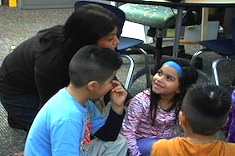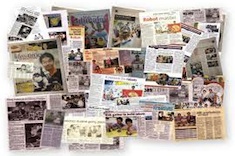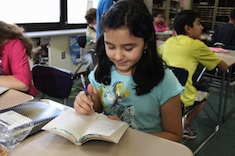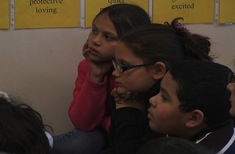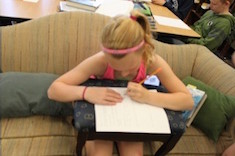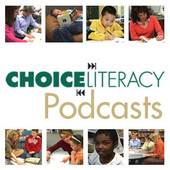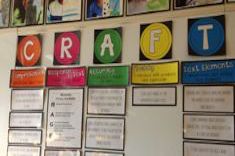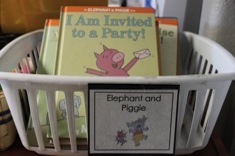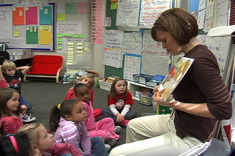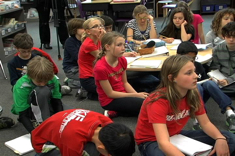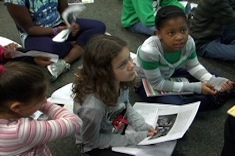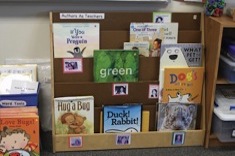Mentor Texts
It's all about the right book at the right time, given to the right student or used in the right lesson . . . Here is where we gather all those suggestions from our contributors for using mentor texts, including lesson protocols and scores of video examples.
Latest Content
Modeling Nonfiction Writing for English Language Learners
Stella Villalba models nonfiction writing for her first- and second-grade English language learners, and in the process integrates vocabulary instruction into her lesson. This is the first video in a three-part series.
From Compliments to Challenges: The Conferring Card
Melanie Meehan uses a conferring card in her writing conference with Cara to ensure she has a record of the strengths and revision possibilities they discussed.
Extended Inquiry with Article of the Week
Gretchen Schroeder finds the article of the week activity is an excellent vehicle for learning about content literacy gaps in student background knowledge and how to fill them.
Getting Mentor Texts in Students’ Hands
Jillian Heise discovers that her students need more access to the mentor texts she reads aloud, so she develops strategies to get them to students.
Understanding Character Traits: Part 2
Jason DiCarlo continues his third-grade reading workshop lesson on character traits with a mentor text. This is the second video in a three-part series.
Mentor Texts and Memoir Writing
Gretchen Schroeder finds one mentor text has many uses as her high school students explore memoir writing.
Resources for Quick-Writes
Katherine Sokolowski shares some of her favorite resources to jumpstart student interest in writing.
Moving Beyond Bed-to-Bed Stories in First Grade
Katrina Edwards moves her first graders from writing "bed-to-bed" stories early in the year with a mentor text and writing activity that promotes self-discipline and a growth mindset.
Ralph Fletcher on Mentor Texts (PODCAST)
If you’re spending some time sifting through new books and thinking about teaching with them, you’ll enjoy this podcast with Ralph Fletcher.
Using Picture Books to Foster Resilience
Gigi McAllister uses picture books to strengthen her fourth-grade classroom community.
Researching Like Writers: From Read-Aloud to Notebooks
Katie Doherty finds read alouds are a valuable tool for developing middle school writers.
Questions and Picture Books
Katie DiCesare suggests some mentor texts for fostering curiosity in young readers.
Nine Picture Books for Teaching Mindfulness
Kim Yaris and Jan Burkins conclude their series on integrating children’s literature and mindful teaching.
Organizing Craft Minilessons
Mary Helen Gensch concludes her series on crafting your own minilessons with tips on organizing and storing your plans.
How to Notice: Mining Children’s Books for Craft Minilessons
This is the second installment in our new series on creating your own writer’s craft minilessons.
Finding Craft Minilessons in the Children’s Books You Love
Mary Helen Gensch explains how to find craft lessons in beloved children’s books. She uses a mentor text with an engaging main character to describe the process. This is the first installment in a three-part series.
Teacher as Mentor Writer
Tony Keefer takes the leap and commits to sharing more of his writing process with students.
Books for Studying Illustration with First Graders
Katie DiCesare has suggestions for books to support an illustration unit early in the year.
Understanding Study: Noticing Pictures
Katie DiCesare’s favorite beginning unit with first graders focuses on illustration.
Endings Minilesson with Second Graders
Cathy Laker uses her own writing as a mentor text with her second-grade students to demonstrate options for endings.
Manipulating Time: Fourth-Grade Writing Minilesson
Tony Keefer uses his writing as a mentor text in this fourth-grade minilesson on manipulating time in personal narratives.
Drama and Two-Page Spreads: Conferring with Max
Ruth Ayres confers with second grader Max about the drama of losing his dog, and the value of using two-page spreads to tell a story.
Act II: Understanding Hamlet Through Close Reading (Shakespeare and the Common Core Series)
Gretchen Schroeder continues her Shakespeare and the Common Core series on teaching the classics in high school, explaining how she uses Hamlet in creative ways to teach close reading strategies.
Rereading for Writing: Conferring with Jack
Katie DiCesare confers with first grader Jack, using rereading to help him rethink the title of his story and possibilities for revision.
Thinking About Theme
Karen Terlecky explains how she designs instruction and uses mentor texts to teach theme, and includes a video example of a minilesson.
November Contract: Family and Memoir
The November installment of Megan Ginther and Holly Mueller’s yearlong literacy contract series has a theme of family and memoir.
Mentor Texts for “Versus” Stories
Shark vs. Train! Fork vs. Spoon! Versus stories are incredibly popular in writing workshops these days. Cathy Mere found herself struggling to teach narrative conventions to students writing versus tales, so she created a booklist of mentor texts.
Owl Research: Whole Class Explanation of Marking Up Text
Students are given a nonfiction text to mark up during a close reading with a partner in this video from Andrea Smith’s fourth-grade classroom.
Mentor Texts for Writing Endings
One goal of many primary teachers is to help students finish their drafts with an ending other than “The End” (or “they lived happily ever after”). Katie DiCesare shows her first graders many alternative examples, and she begins early in the year.
First Grade Read Aloud: Sergio Saves the Game
Katie DiCesare reads aloud Sergio Saves the Day to her first graders as part of a unit on understanding literary characters.
Browse Content By
Type
Category
- Assessment Tools
- Big Fresh Archives
- Booklists
- Choice Numeracy
- Classroom Design
- Common Core
- Community Building
- Conferring
- Content Literacy
- Digital Literacy
- English Language Learners
- Equity
- Family Relations
- Free Samples
- Guiding Groups
- Leadership
- Literacy Coaches
- Mentor Texts
- Minilessons
- New Teacher Mentors
- Podcasts
- Poetry
- Quote Collections
- Reading Strategies
- Self Care
- Struggling and Striving Learners
- Talking and Listening
- Teacher Study Groups
- Teaching Reading
- Teaching Writing
- Word Study and Vocabulary
Author
- Melissa Quimby
- Nawal Qarooni
- Gwen Blumberg
- Julie Cox
- The Lead Learners
- Hannah Tills
- Josie Stewart
- Ruth Metcalfe
- Mallory Messenger
- Becca Burk
- Jodie Bailey
- Vivian Chen
- Mary Brower
- Tiffany Abbott Fuller
- Stephanie Affinito
- Ruth Ayres
- Leigh Anne Eck
- Heather Fisher
- Shari Frost
- Julie Johnson
- Suzy Kaback
- Gigi McAllister
- Shirl McPhillips
- Melanie Meehan
- Cathy Mere
- Debbie Miller
- Tara Barnett and Kate Mills
- Tammy Mulligan
- Dana Murphy
- Bitsy Parks
- David Pittman
- Brenda Power
- Heather Rader
- Matt Renwick
- Mandy Robek
- Christy Rush-Levine
- Gretchen Schroeder
- Jen Schwanke
- Brian Sepe
- Katherine Sokolowski
- Stella Villalba
- Jennifer Vincent
Grade Level
Choice Literacy Membership
Articles
Get full access to all Choice Literacy article content
Videos
Get full access to all Choice Literacy video content
Courses
Access Choice Literacy course curriculum and training

